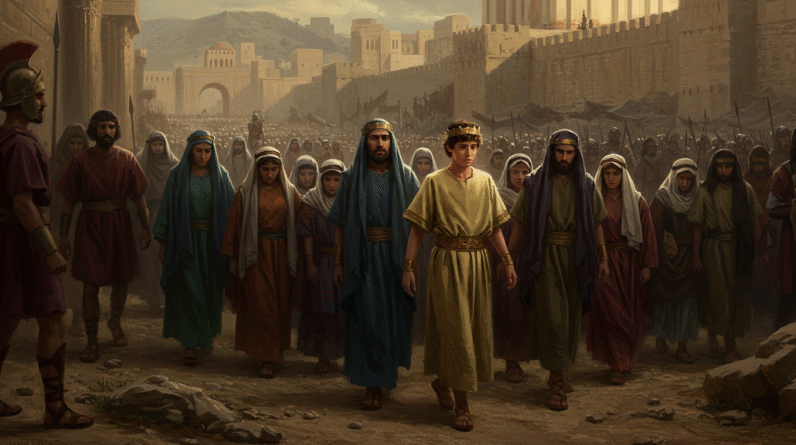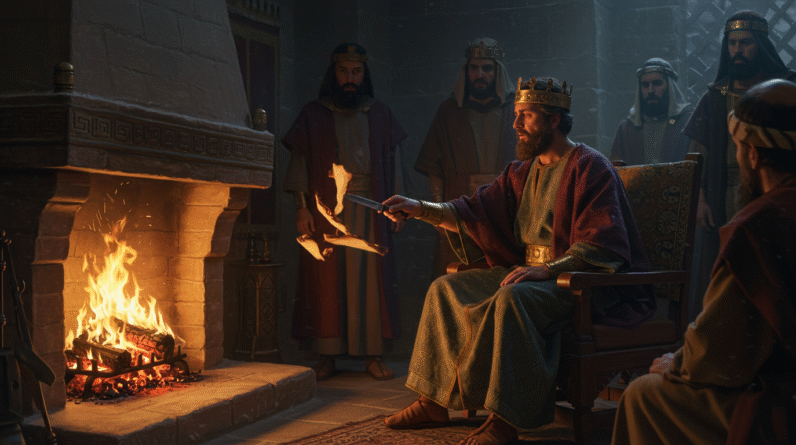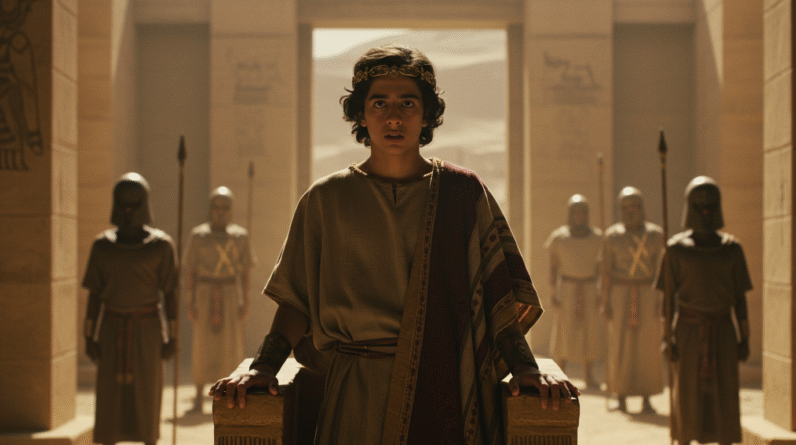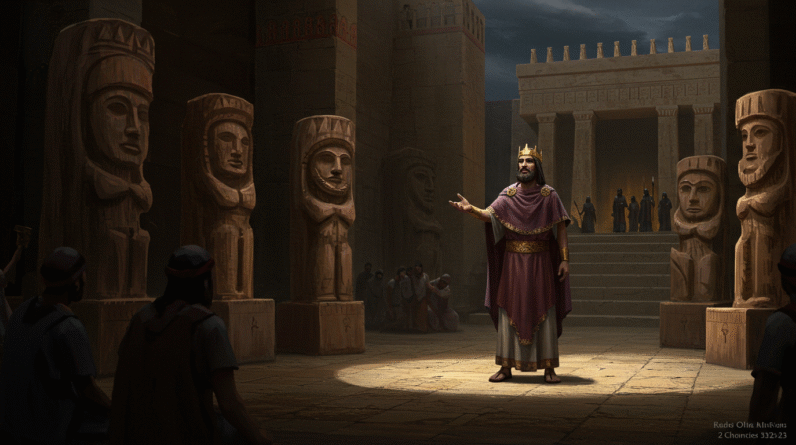Joash: The Boy King Who Repaired God’s Temple (2 Kings 12:4–5)
You come to this story expecting a child on a throne, and you do get that. You expect decisive acts—repair, reform—and you get them too. But you also get the strange, human things that happen inside court rooms and city walls: influence, memory, neglect, and the small moral failures that compound into bigger ruin. The scene in 2 Kings where Joash begins to care for the temple is at once practical and theological, intimate and public. It’s about money and mortar, yes, but it’s also about what people do with what they inherit: a house of God, a memory of kings and prophets, and the fragile devotion of a nation. Read the account and you’ll find cure and contagion together.
Joash as a child and a king
You will notice the oddness of childhood in power. Joash is only seven when the crown goes on his head. You know what a seven-year-old is like: curious, impressionable, sometimes relentless in wanting what seems right. But a coronation is not a play. The child becomes the center, unexpectedly, of national future and ritual life. The chronicler tells you that he reigned for many years, and your instinct is to watch him like someone inspecting a fragile vase.
The compact account in 2 Kings opens with his age and reign: 2 Kings 12:1-3. Those lines also introduce the guiding figure of Jehoiada. The priest’s presence is a constant: he raises the child, he shapes the values around him, and he becomes the instrument by which the temple is to be cared for. You see here a dynamic repeated across history—the tender figure who trains power to be kind, and the latent risk that tenderness, when it leaves, allows for cruelty.
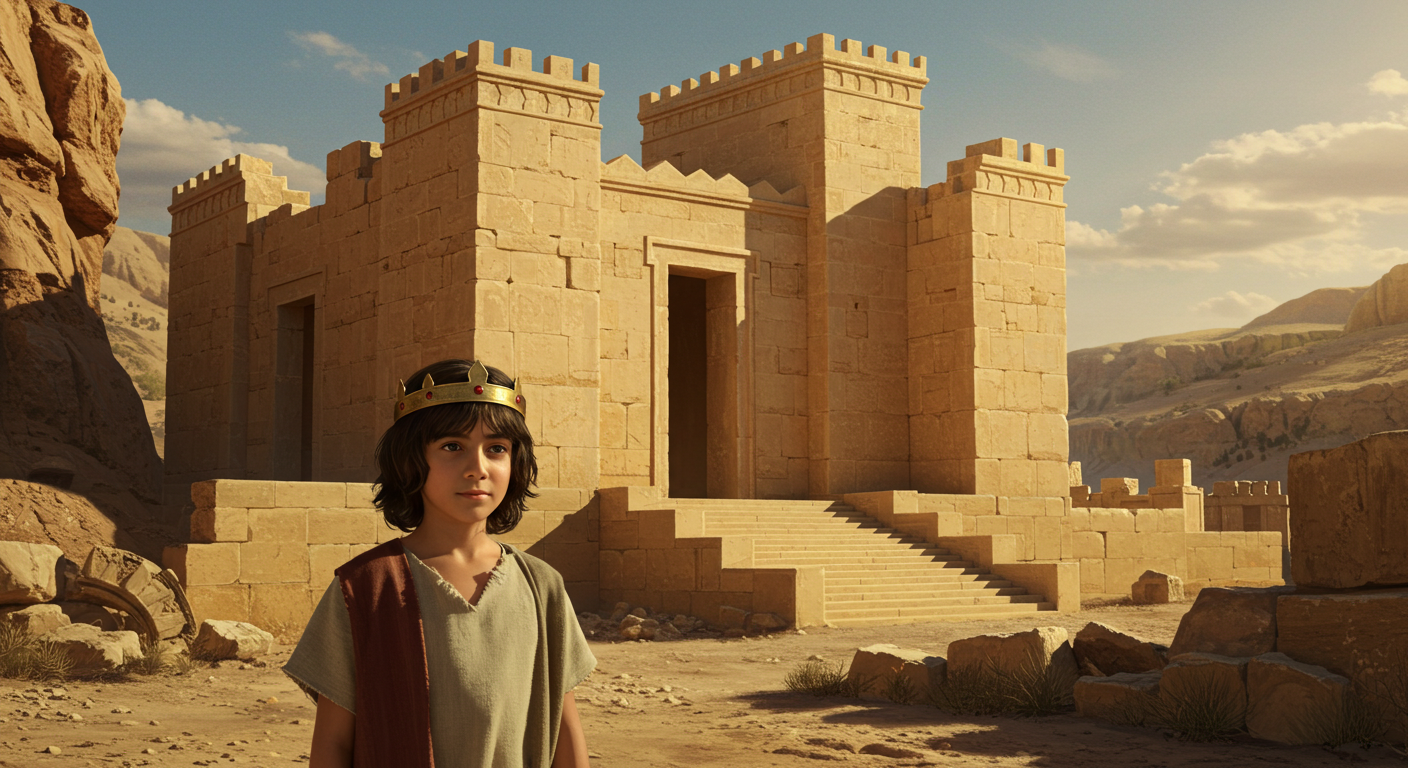
The backdrop: Judah after Athaliah
You should picture Jerusalem after violence and a queen who tried to end a dynasty. Athaliah had ruled in a way that flattened the court into terror, so when she was overthrown, there was relief and a sense of new beginnings. But emergency restorations do not erase what came before. The city and its people were still raw with grief and with the absence of steady leadership. That makes Joash’s story not only about a temple, but about how a society tries to stitch itself together again.
For the political setup, the story of how Joash was hidden and then crowned is in 2 Kings 11. Read how Jehoiada the priest orchestrated the preservation and enthronement of the child-king after Athaliah’s purge: 2 Kings 11:1–3 and the following verses that describe the coup and anointing 2 Kings 11:4–21. These chapters show you how priestly authority and royal legitimacy intertwine. Jehoiada’s role is not just background; it’s structural. He is the adult who keeps the child alive and then teaches him to take a step back into rule.
The temple as a symbol and a necessity
When the narrative turns to the temple in 2 Kings 12, it isn’t only concerned with a building. The temple stands for the covenant memory of Israel, the ritual center of worship, and the visible testament that God’s presence is not an abstraction but localized. You can think of the temple as the nation’s public conscience, a place where what belongs to God is stored and where the nation meets its maker.
Verse 4 begins the section on repairs: 2 Kings 12:4-5. The text is practical and unembellished. Jehoiada notices the need. He sees that the house of God is in disrepair and devises a means of collecting money. This is not grand theology; it’s logistics. It is also faith lived through responsibility. You can almost picture Jehoiada at the threshold, counting what isn’t there anymore: broken doors, worn altars, copper foundations eaten by time.
The method: collection and accountability
You might expect that kings act by decree and kings act by force. But here, repair is not simply taken from the royal treasury. Jehoiada sets up a system that calls people to give voluntarily into a chest—a chest that was guarded and placed near the entrance to the temple. The method is deliberate: it ties individual responsibility to communal worship. It obliges you, as a participant in the nation, to determine whether you care for the sacred things you share.
The chronicler’s parallel account in 2 Chronicles describes how Jehoiada organized overseers and craftsmen and how the funds were collected from all who came to the temple: 2 Chronicles 24:4–14. The mechanism is almost modern—collection boxes, oversight, and registered spending. You sense an ethic here: money for worship should be transparent, handled by accountable leaders, and directed to concrete needs. Jehoiada’s plan is administrative, not merely devotional.
Jehoiada’s wisdom and the problem of trust
When you examine how Jehoiada acted, you notice that trust is a fragile thing that leaders manufacture. He trusted the people to give; he trusted officials to spend correctly; he trusted that the king would not usurp the project for vanity. That trust requires a culture that values covenant and continuity. In the short term, it worked. The repairs proceeded because someone created a reliable channel and enforced it.
You see Jehoiada’s foresight in appointing gatekeepers for the treasury and overseers for the construction in 2 Chronicles 24:5–8: 2 Chronicles 24:5–8. But even the best systems cannot guard forever. You sense that the story is quietly preparing you for how institutional care sometimes fails: those who begin a work are not always those who finish it.
The temple as a symbol and a necessity
When the narrative turns to the temple in 2 Kings 12, it isn’t only concerned with a building. The temple stands for the covenant memory of Israel, the ritual center of worship, and the visible testament that God’s presence is not an abstraction but localized. You can think of the temple as the nation’s public conscience, a place where what belongs to God is stored and where the nation meets its maker.
Verse 4 begins the section on repairs: 2 Kings 12:4-5. The text is practical and unembellished. Jehoiada notices the need. He sees that the house of God is in disrepair and devises a means of collecting money. This is not grand theology; it’s logistics. It is also faith lived through responsibility. You can almost picture Jehoiada at the threshold, counting what isn’t there anymore: broken doors, worn altars, copper foundations eaten by time.
The method: collection and accountability
You might expect that kings act by decree and kings act by force. But here, repair is not simply taken from the royal treasury. Jehoiada sets up a system that calls people to give voluntarily into a chest—a chest that was guarded and placed near the entrance to the temple. The method is deliberate: it ties individual responsibility to communal worship. It obliges you, as a participant in the nation, to determine whether you care for the sacred things you share.
The chronicler’s parallel account in 2 Chronicles describes how Jehoiada organized overseers and craftsmen and how the funds were collected from all who came to the temple: 2 Chronicles 24:4–14. The mechanism is almost modern—collection boxes, oversight, and registered spending. You sense an ethic here: money for worship should be transparent, handled by accountable leaders, and directed to concrete needs. Jehoiada’s plan is administrative, not merely devotional.
Jehoiada’s wisdom and the problem of trust
When you examine how Jehoiada acted, you notice that trust is a fragile thing that leaders manufacture. He trusted the people to give; he trusted officials to spend correctly; he trusted that the king would not usurp the project for vanity. That trust requires a culture that values covenant and continuity. In the short term, it worked. The repairs proceeded because someone created a reliable channel and enforced it.
You see Jehoiada’s foresight in appointing gatekeepers for the treasury and overseers for the construction in 2 Chronicles 24:5–8: 2 Chronicles 24:5–8. But even the best systems cannot guard forever. You sense that the story is quietly preparing you for how institutional care sometimes fails: those who begin a work are not always those who finish it.
The specifics: what was repaired and why it mattered
You should ask what exactly was repaired. The text mentions the house of the LORD, the court and the walls, and the vessels that were in the temple. These are not frivolous details. The vessels are instruments for ritual, the court is where people meet God, and the walls are not only for security but for identity. Repairing them is an act of restoring functionality and dignity.
2 Kings 12 gives a direct account of the repair work and how the money was collected and used: 2 Kings 12:6-16. The description is efficient: you see account books and appointed craftsmen. There is a rhythm: collection, testing, purchasing, and rebuilding. It’s the rhythm of responsible covenant maintenance. When a people neglect their shared holy spaces, they risk losing the rituals that keep them aligned with their founding stories. Joash’s repairs are, in this sense, an attempt to re-anchor the nation’s memory.
The role of the king: patron or puppeteer?
You will notice ambiguity about Joash’s agency. Sometimes the text credits the priest more than the king; sometimes the king seems to be in the background. That’s important. Joash begins under the mentorship of Jehoiada, and for many years, he follows the priest’s counsel. But kingship is seductive. Ruling requires the appearance of power, even if the real direction comes from someone else. It’s easy to let the trappings of authority slowly widen into genuine control.
In 2 Chronicles 24:2–3 you see how Joash did what was right as long as Jehoiada lived; the priest’s death becomes the hinge: 2 Chronicles 24:1–3. You can feel the foreboding in those verses: when the guardian of the king’s conscience is gone, the dynamics of power shift. The old saying comes to mind—you can see how people who are never weaned from supervision may not learn to manage their own moral appetite.
The turning point: Jehoiada’s death and Joash’s decline
You’ll notice a delicate, almost everyday transition. Jehoiada dies, and Joash’s direction becomes less certain. It doesn’t happen in a dramatic single act at once, but rather in the small choices that follow. He is susceptible to the influence of others, particularly the officials and his wives, and the story that follows is unpleasant in its predictability. The reforms that kept the temple cared for unfolded.
The chronicler does not obscure the shift. After Jehoiada’s death, the princes of Judah come and encourage Joash into idolatry, and he listens. The catalogue of blame is explicit in 2 Chronicles 24:17-22: 2 Chronicles 24:17-22. The temple repair that had seemed like an anchor becomes a memory, and the king’s failure is moral as well as administrative. You watch how responsibility can become performative when the scaffolding that made it real is gone.
Discipline and consequence
There is a grim part of the story where prophets are sent to call the nation to repentance. Zechariah, the son of Jehoiada, speaks against the people’s apostasy and is killed by royal command. That murder is heavy in the narrative because it closes a circle: Jehoiada had protected Joash as a boy, and Jehoiada’s son is executed by the same authority the priest once safeguarded. The text makes this cause-and-effect moral plain.
You can read the prophet Zechariah’s death in 2 Chronicles 24:20-22: 2 Chronicles 24:20-22. The impotence of institutional religion, when divorced from genuine repentance, is exposed here. It is not simply the failure of a king but the failure of a society to heed correction. The narrative gives you a stark view of how the structures built to support holiness can be hollow if the people do not hold them with sincerity.
Comparing the accounts: Kings and Chronicles
You might wonder why there are two accounts—2 Kings and 2 Chronicles—that look at similar events but with different emphases. Kings tend to be more sparse and political. Chronicles is more reflective, priestly, and concerned with cultic fidelity. When you read both, you get a fuller picture. Kings focuses on the political arc. Chronicles is interested in the religious praxis and the moral evaluation of a king’s heart toward God’s house.
For the record, compare the main accounts: Joash’s reign and actions in 2 Kings 12:1–16 2 Kings 12:1–16 and the extended priestly perspective in 2 Chronicles 24:1–16 2 Chronicles 24:1–16. You’ll see Chronicles linger over Jehoiada’s role and Zechariah’s fate, and you’ll see Kings give you the practical pattern of repair and funding. Together, they teach you how temple care and royal character are braided.
Leadership lessons you can use
There are several practical lessons you can take away. They are modest, not aphoristic, and they sit in the small administrative choices that make public life possible.
- You need accountability structures. Jehoiada didn’t just tell people to give—he organized, appointed gatekeepers, and kept records. You see that care needs systems.
- Leadership needs guardians. Joash flourished under Jehoiada’s mentorship and faltered after his death. You ought to seek counsel and to pass on the norms that sustain you.
- Money matters morally. How funds are gathered and spent reveals what you truly honor. The temple’s repair shows the spiritual embedded in the fiscal.
- Institutions can’t replace conscience. The temple can be fixed and still become an empty building. genuine revival requires inward change, not just outward restoration.
Each lesson is small, but they accumulate. You can map them onto your own life—your workplace, your family, your community—and see how small administrative virtues sustain the bigger ones.
Theology in action: worship as community responsibility
If you take the theology seriously, what is at stake is not only ritual correctness, but how a community participates in God’s presence. The repairs were meant so that worship might be conducted rightly. That’s a theological claim about the body of worship—it needs a home, and the home must be tended. Worship isn’t just private piety; it’s a collective practice that depends on public goods.
The narrative puts emphasis on the sanctity of the shared environment. The temple’s vessels, the courts, and the very stones play a role in forming the people’s rhythm. You can read that in 2 Kings 12 and its parallel: 2 Kings 12:4–5 and 2 Chronicles 24:4–5. The theology is not abstract: it’s literally about the furniture of faith.
Memory and heritage: what you inherit
You inherit more than objects. You inherit a history of choices. The temple is a thing, yes, but the deeper inheritance is a set of practices, a priestly ethic, a memory. Jehoiada passes on to Joash not just the care of wood and stone, but a sense of duty. When that passes away, the inherited memory frays.
Think of yourself as inheriting a family habit. Maybe it was a way of praying, or a method of argument, or a sense of what counts as worth defending. Those things are not inevitable. They require tending. The story asks you to be faithful to what you have been given and also to notice what you do with it.
On repentance, reform, and relapse
There is a rhythm to Joash’s life that carries in it the possibility of repentance and the reality of relapse. He starts with reformation—repairing the temple, restoring worship—and then he drifts. The presence of prophets calling for reform and the violent response to Zechariah show you the complexity of religious change: it is not linear. Reform can be genuine and short-lived. Repentance can be national and ephemeral.
Read the sobering aftermath in 2 Chronicles 24:17–22 where the prophetic voice is stifled and the king’s heart hardens: 2 Chronicles 24:17–22. The narrative is not content to let you idealize Joash; it compels you to watch the cost of moral lapses. There is a lesson here about vigilance: you don’t arrive at character and stay there simply because you once acted rightly.
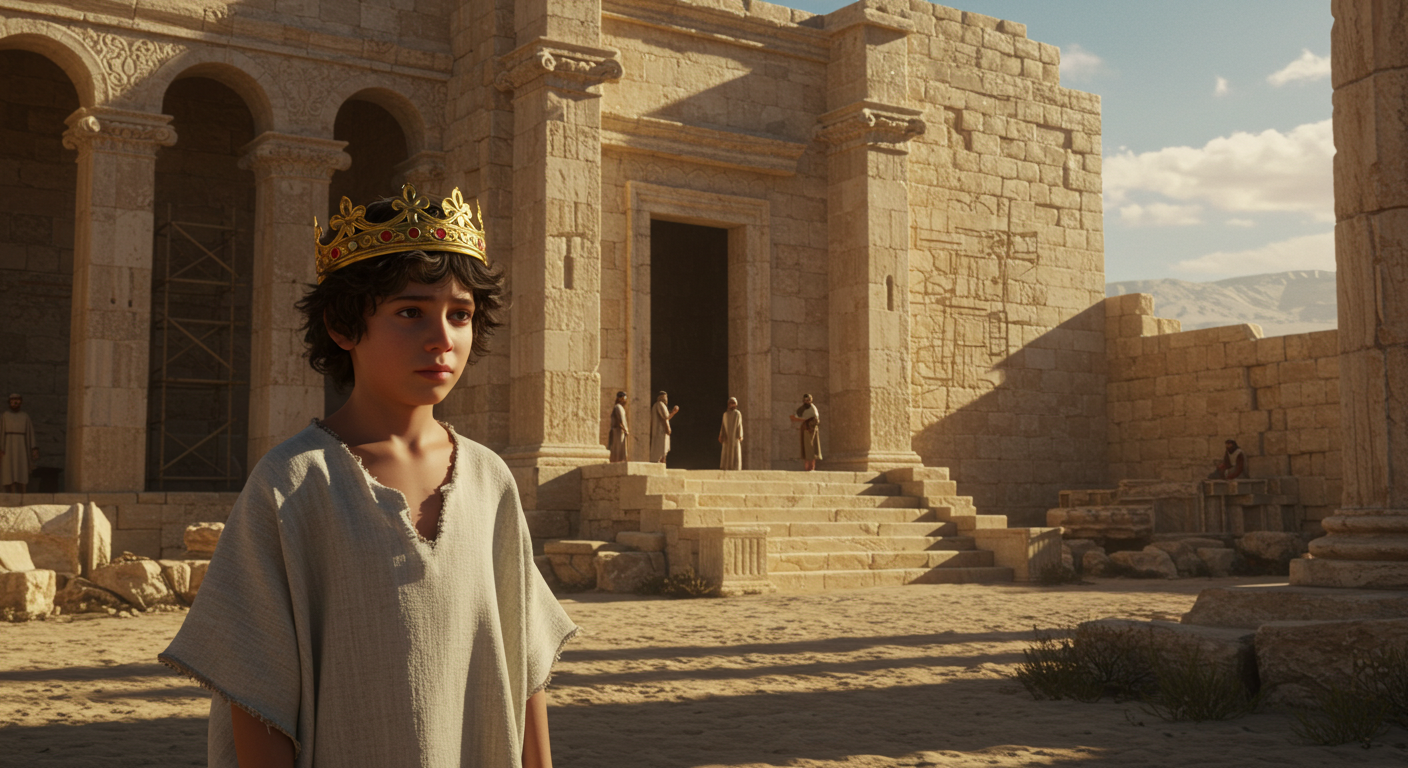
Joash in the wider sweep of Judah’s kings
If you place Joash in the larger genealogy of Judah’s leaders, you can see him as symptomatic of a pattern: periods of reform followed by decay. Kings who begin well often end poorly. The prophetic tradition within Israel repeatedly diagnoses the same sickness: outward religiosity without inward fidelity. Joash’s brief moral success and later failure capture that recurring national drama.
You can see that pattern in comparative accounts of other kings, but the focal point here is the nexus of palace, priesthood, and people. Jehoiada is the link. When the link is severed, the moral architecture crumbles. That pattern recurs across the histories. Look at the broader narrative and you see cycles—good leadership followed by degeneration, then prophetic rebuke, and so on.
Why this ancient account matters for you now
You might think this is a remote story, a relic of a different covenantal world. But it matters because it teaches about human institutions. You live within institutions and inherit practices. You make small choices about stewardship. The way Joash handled—or failed to handle—his inheritance has echoes in boardrooms, congregations, families, and governments. The structural elements are the same: mentorship, oversight, accountability, and the temptation of power.
When you decide how you will use resources—public funds, family savings, the reputation someone entrusted to you—you are engaged in the same moral economy that Jehoiada and Joash navigated. If you ask what it means to be faithful in a community, you’ll find this story surprisingly relevant.
What you can practically do
You don’t need to become a biblical scholar to apply these lessons, but you can be intentional. Practical steps you might take include ensuring transparency in how communal funds are handled, cultivating mentors and reliable counsel, and encouraging the rotation of power so that no single person hoards unaccountable influence. Create rituals that are more than ornament: small, regular practices that reinforce the values you want to keep alive.
The story’s administration model is instructive. Jehoiada didn’t rely on charisma; he built systems. You can do the same. Structure the work you care about so it doesn’t depend only on a single hero. Design oversight, make giving accessible and accountable, and keep the focus on the community’s shared purpose.
The sadness and the grace
You will feel a melancholic thread in this account. There is a sorrow in watching what could have been preserved unravel because of gradual compromises. But there is also grace in the initial efforts. The repairs are real, the work is practical, and for a time, the temple was made fit again. That mixture of repair and regret is perhaps the most human part of the text. You recognize it in your own life: attempts that succeed temporarily, failures that teach you, and a longer patience that keeps you trying.
This is why the chronicler includes both the renovation and the downfall. The memory of faithful acts remains as a witness. Even failed kings are not wholly erased. The repair work you do matters, even if you cannot control the future in which others squander it.
Questions to sit with
You should take a moment to sit with a few questions the story raises, not because they have neat answers, but because they expand your moral imagination: Who are the Jehoiadas in your life? Which institutions escape your attention until they begin to fall apart? How does money shape what you call sacred? What systems can you build now to ensure that what you value persists beyond your tenure?
These questions are practical and existential. They are invitations rather than indictments.
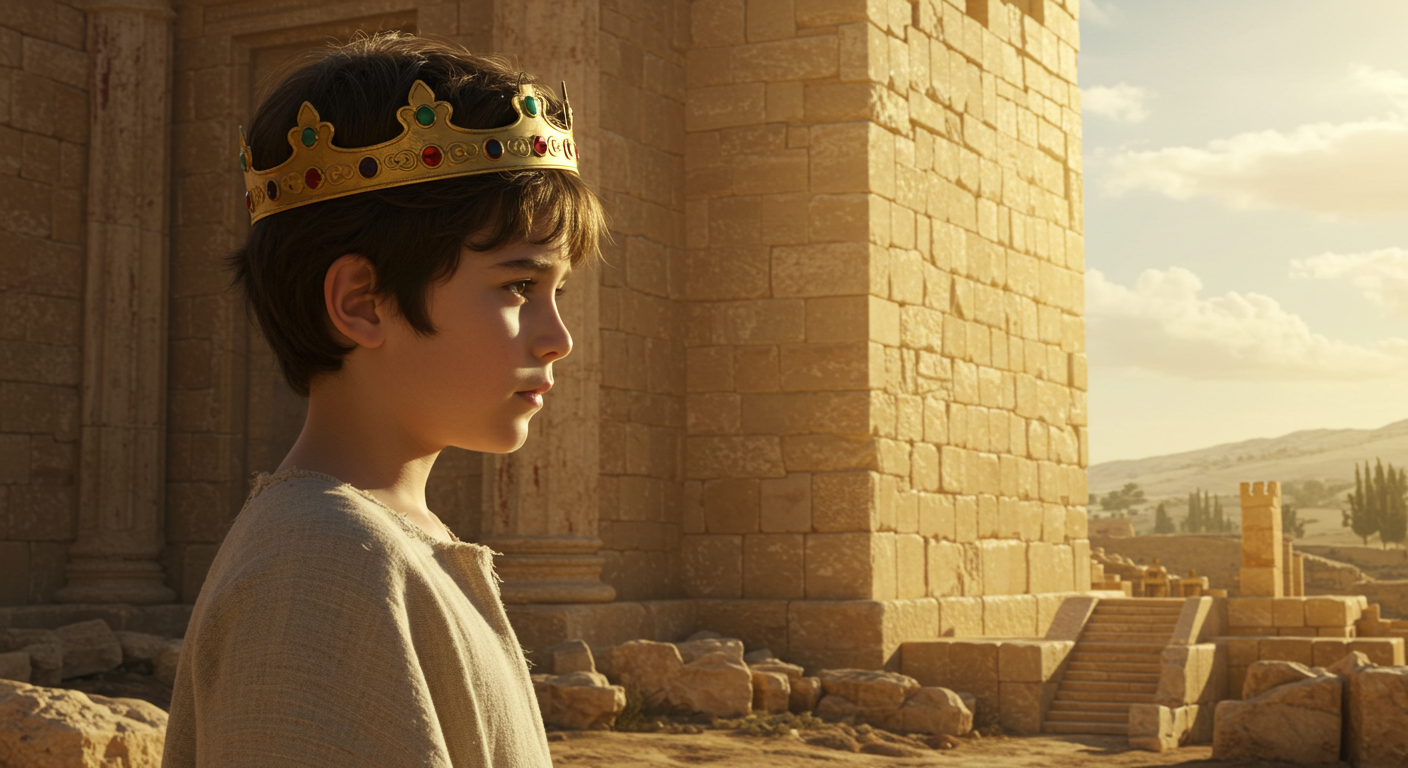
Final reflection
Joash is a story about the everyday architecture of faith. It is about gatekeepers and boxes, about stones and altars, about the way a boy becomes king and learns the hard limits of his power. You find in it both the beauty of repair—the civic piety of a people collecting to rebuild what matters—and the tragedy of moral drift. Read the passages for yourself and let the dryness of the text unsettle you a little. It is not simply a tale about a building; it is a mirror for how you steward and sustain what you inherit.
For the primary biblical texts, start with the repair account in 2 Kings: 2 Kings 12:4–5 and then read the fuller context in 2 Kings 12:1–16. Compare the chronicler’s angle in 2 Chronicles 24:1–16 and the later account of Zechariah’s death in 2 Chronicles 24:17–22. For the political setup and Jehoiada’s coup, read 2 Kings 11:1–21.
Explore More
For further reading and encouragement, check out these posts:
👉 7 Bible Verses About Faith in Hard Times
👉 Job’s Faith: What We Can Learn From His Trials
👉 How To Trust God When Everything Falls Apart
👉 Why God Allows Suffering – A Biblical Perspective
👉 Faith Over Fear: How To Stand Strong In Uncertain Seasons
👉 How To Encourage Someone Struggling With Their Faith
👉 5 Prayers for Strength When You’re Feeling Weak
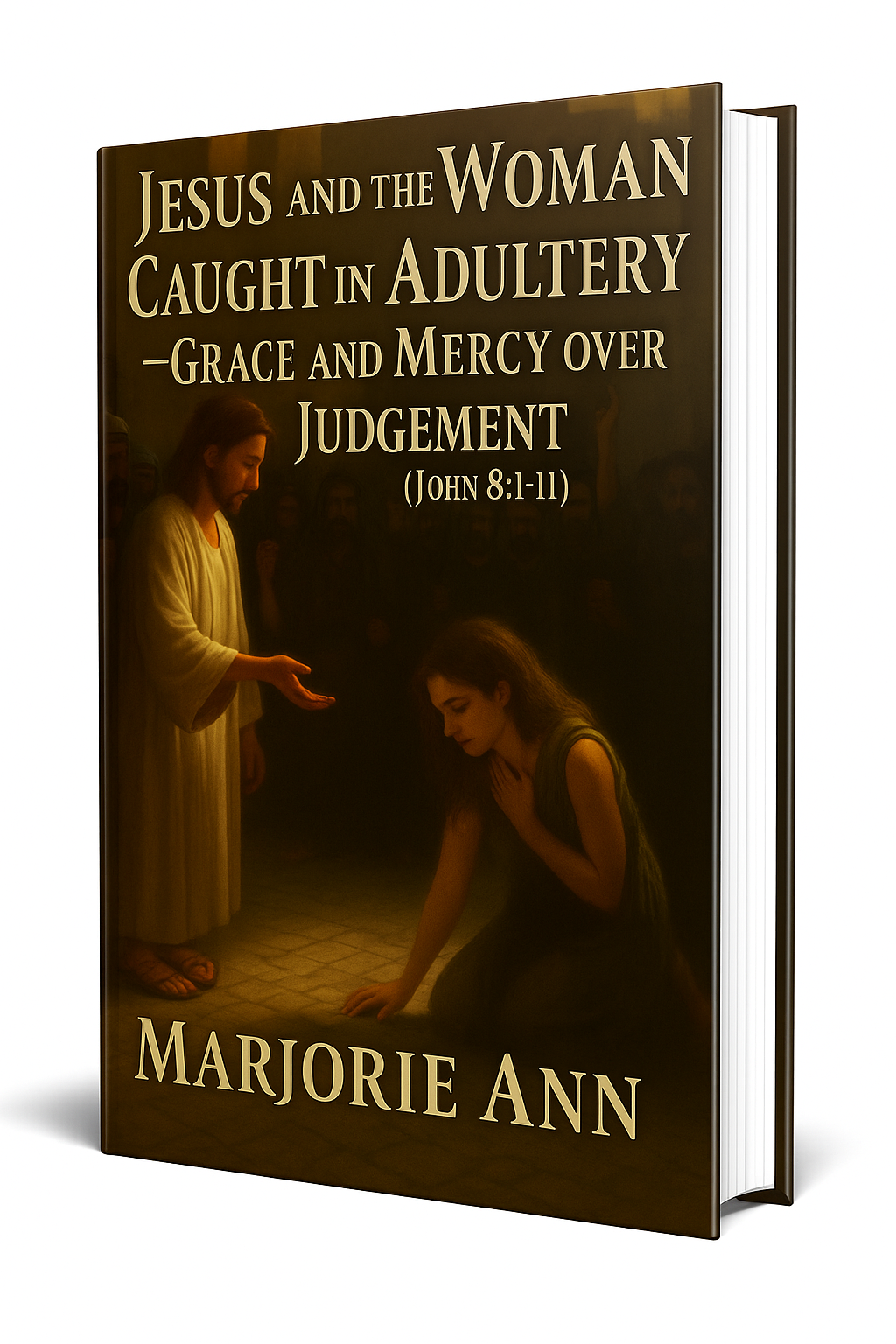
📘 Jesus and the Woman Caught in Adultery – Grace and Mercy Over Judgement
A powerful retelling of John 8:1-11. This book brings to life the depth of forgiveness, mercy, and God’s unwavering love.
👉 Check it now on Amazon
As a ClickBank Affiliate, I earn from qualifying purchases.
Acknowledgment: All Bible verses referenced in this article were accessed via Bible Gateway (or Bible Hub).
“Want to explore more? Check out our latest post on Why Jesus? and discover the life-changing truth of the Gospel!”




